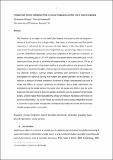Files in this item
A shape-level flanker facilitation effect in contour integration and the role of shape complexity
Item metadata
| dc.contributor.author | Gillespie, Christopher | |
| dc.contributor.author | Vishwanath, Dhanraj | |
| dc.date.accessioned | 2020-03-08T00:31:59Z | |
| dc.date.available | 2020-03-08T00:31:59Z | |
| dc.date.issued | 2019-05 | |
| dc.identifier | 258156653 | |
| dc.identifier | ca05a3cc-c921-4c3e-b811-2c976050191a | |
| dc.identifier | 85062669703 | |
| dc.identifier | 000473117800023 | |
| dc.identifier.citation | Gillespie , C & Vishwanath , D 2019 , ' A shape-level flanker facilitation effect in contour integration and the role of shape complexity ' , Vision Research , vol. 158 , pp. 221-236 . https://doi.org/10.1016/j.visres.2019.02.002 | en |
| dc.identifier.issn | 0042-6989 | |
| dc.identifier.other | ORCID: /0000-0002-8095-0537/work/64697704 | |
| dc.identifier.uri | https://hdl.handle.net/10023/19617 | |
| dc.description | This work by funded by an EPSRC doctoral training grant at the University of St Andrews. | en |
| dc.description.abstract | The detection of an object in the visual field requires the visual system to integrate a variety of local features into a single object. How these local processes and their global integration is influenced by the presence of other shapes in the visual field is poorly understood. The detectability (contour integration) of a central target object in the form of a two dimensional Gaborized contour was compared in the presence or absence of nearby surrounding objects. A 2-AFC staircase procedure added orientation jitter to the constituent Gabor patches to determine the detectability of the target contour. The set of contours was generated using shape profiles of everyday objects and geometric forms. Experiment 1 examined the effect of three types of congruencies between the target and two flanking contours (contour shape, symmetry and familiarity). Experiment 2 investigated the effect of varying the number and spatial positions of the flankers. In addition, a measure of shape complexity (reciprocal of shape compactness) was used to assess the effects of contour complexity on detection. Across both experiments the detectability of the target contour increased when the target and flanker had the same shape and this was related to both the number of flankers and the complexity of the target shapes. Another factor that modulated this shape-level flanker facilitation effect was the presence of symmetry. The overall results are consistent with a contour integration process in which the visual system incorporates contextual information to extract the most likely smooth contour within a noise field. | |
| dc.format.extent | 2216976 | |
| dc.language.iso | eng | |
| dc.relation.ispartof | Vision Research | en |
| dc.subject | Contour integration | en |
| dc.subject | Object detection | en |
| dc.subject | Complexity | en |
| dc.subject | Perceptual grouping | en |
| dc.subject | Figure-ground organization | en |
| dc.subject | Shape | en |
| dc.subject | Pictures | en |
| dc.subject | BF Psychology | en |
| dc.subject | NDAS | en |
| dc.subject.lcc | BF | en |
| dc.title | A shape-level flanker facilitation effect in contour integration and the role of shape complexity | en |
| dc.type | Journal article | en |
| dc.contributor.institution | University of St Andrews. School of Psychology and Neuroscience | en |
| dc.contributor.institution | University of St Andrews. Institute of Behavioural and Neural Sciences | en |
| dc.identifier.doi | https://doi.org/10.1016/j.visres.2019.02.002 | |
| dc.description.status | Peer reviewed | en |
| dc.date.embargoedUntil | 2020-03-08 |
This item appears in the following Collection(s)
Items in the St Andrews Research Repository are protected by copyright, with all rights reserved, unless otherwise indicated.

